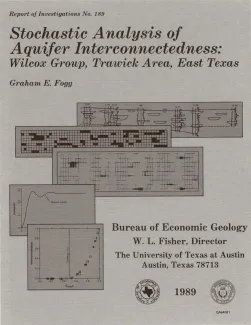
Publication Details
Geolocation:
Get the Publication
$13.00
Abstract/Description:
Detailed characterization of the spatial distribution of hydraulic conductivity (K) by direct measurement is usually impractical. A viable alternative is to use geologic information and geostatistics to characterize interconnectedness of critical K facies that have a dominant influence on fluid flow. Conditional simulation is introduced herein as a method for estimating aquifer interconnectedness. Facies continuity is accounted for by the variogram, which can be determined by conventional means or synthesized from information on average dimensions and fractional content of the K facies of interest.A test case in a 6 by 11 mi (10 by 18 km) region in the East Texas Wilcox Group, a fluvial multiple aquifer system, demonstrates the feasibility of this approach. Two-dimensional conditional and unconditional simulations of channel-sand distribution along a strike cross section indicate sensitivity of interconnection probability (P) and equivalent K to sand-bod) continuity, variogram range and model, flow-region length, and sand fraction (SF). Conditional simulations are generated efficiently with an improved matrix technique that takes advantage of the vertical continuity of geophysical log data.Results show that if the variogram and SF can be estimated, continuity and interconnectedness of facies in stationary systems can be characterized with acceptable accuracy. However, P and equivalent K are much more sensitive to SF than to the variogram range or model. Removal of data from the simulations causes loss of local detail on interconnection frequency but does not noticeably change the overall average continuity of sands or equivalent K. P exhibits threshold behavior, increasing abruptly when SF exceeds 0.3 to 0.5. The relationship between SF and equivalent K differs from that predicted by percolation theory owing to the presence of spatial correlation and nonzero K values assigned to the interchannel facies.